| |
|
|
 |
|
| Letters and comments by Ernani
Costantini on the Women of the Bible |
|
| |
|
|
|
|
|
|
|
|
|
|
| |
|
|
|
|
|
|
|
|
|
|
| |
|
Among the documents written about the pictorial
cycle Women of the Bible left by Ernani, there are also some of his
letters about the execution of his work and other subsequent commentary.
Various passages taken from a selection of interesting texts are included,
which are particularly indicative of the artist’s complex approach
to his painting, a product of his wide-ranging cultural experiences
articulated and matured in conjunction with literary, pictorial, musical,
and emotional associations, to create a compendium of multiform experiences,
which, as Ernani himself wished, may lend itself to infinite interpretation. |
|
|
|
|
|
|
| |
|
|
|
|
|
|
|
|
|
|
| |
|
|
|
|
|
|
|
|
|
|
| |
|
|
|
|
|
|
|
|
|
|
| |
|
|
|
|
|
|
|
|
|
|
| |
|
|
|
|
|
|
|
|
|
|
| |
|
|
|
|
|
|
|
|
|
|
| |
|
|
|
|
|
|
|
|
|
|
| From a letter to the critics Guido Perocco
and Paolo Rizzi* |
|
|
|
|
| |
|
|
|
|
|
|
|
|
|
|
| |
|
|
|
|
|
|
|
|
|
|
| |
|
My dear gentlemen, I hope you will not
be shocked that I am addressing this letter to both of you. As I had
the same purpose, and needed to say the same things to both and considering
our friendship, I thought that it would be acceptable to do so. […]
Following several years of doubt and hesitation I have decided to tackle
an artistic task of the stature of those typical of past times: a cycle
of paintings (12 to be precise) on a single theme; like one great narrative
[…]
I am among the few people in the world who still paint in the belief
that painting is still a means of telling stories which are comprehensible
to all, in order to express feeling and thoughts, and to create poetry.
[…] They are inspired by characters from the Bible even though
they are not intended for a church but only for display and to be “read” with
the aid of the accompanying extracts taken from the Holy Scriptures.
[…]
It is the story of Salvation seen and interpreted from a personal viewpoint,
through these figures of women whom God placed along the journey of
mankind. Some of them have shaped history; all have shaped our conscience
[…]. |
|
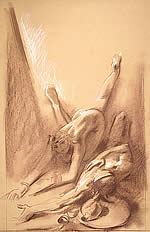 |
|
Study of Delilah and Samson |
| |
|
|
|
|
| |
|
|
| |
|
|
|
|
 |
 |
 |
 |
 |
|
| |
|
|
|
|
|
|
|
|
|
|
| |
|
* Typewritten draft by E. Costantini, November 1984 |
|
|
|
|
|
|
| |
|
|
|
|
|
|
|
|
|
|
| |
|
|
|
|
|
|
|
|
|
|
| |
|
|
|
|
|
|
|
|
|
|
| |
|
|
|
|
|
|
|
|
|
|
| From two letters to Don Antonio Tarzia
at the Pia Società San Paolo in Milan* |
|
|
|
|
| |
|
|
|
|
|
|
|
|
|
|
| |
|
|
|
|
|
|
|
|
|
|
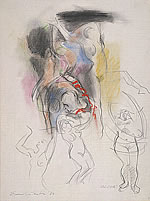 |
| |
Preliminary sketches for
the dance of Salome |
|
|
Now, after the completion of a long series
of works for the churches of Venice and the Veneto, I have begun – in
fact I am almost at the end of – a pictorial cycle which I had
been pondering over for years. It is dedicated to “The women
of the Bible from Eve to Mary” […] I have chosen twelve
of them but there could have been fifty. I chose them for their congeniality
or perhaps because they are the ones that over the long course of my
reading appeared more alive before me, or because they had stuck in
my memories […]. I don’t know. I should have drawn up
a plan of work in accordance with my strength ( or should I say weakness?)
[…].
My paintings […] Despite being – I suppose – easily
interpretable, are non merely illustrative. On the contrary ! The
combination of inventions, colours, and rhythms tends to lead to
a personal interpretation – both emotionally and symbolically – of
the stories and characters in question. […] It is therefore
a matter of a culmination of cultural experiences from different
periods since the emotions resulting from the Bible readings are
associated with literary memories […] from memories of the
great pictorial tradition to “ethnic ”, geographical
and even musical sensations. It is like a compendium of different
kinds of experiences […] all in all a work which lends itself – I
hope – to infinite interpretation […] |
|
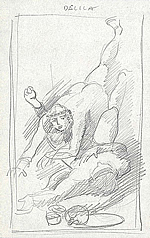 |
|
Study of the composition of Delilah and Samson |
| |
|
|
|
|
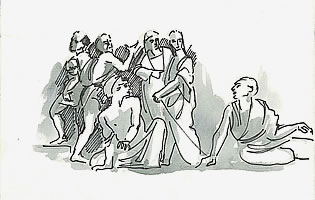 |
| |
|
|
|
|
| Study for Salome: the banquet
guests |
| |
|
|
|
|
 |
 |
 |
 |
 |
|
| |
|
|
|
|
|
| |
|
* Typewritten draft by E. Costantini,
January and February 1985.
During that time Ernani Costantini had taken part in a collective exhibition
held in Milan on the theme of Saint Paul in contemporary art with his
Triptych of Charity |
|
| |
|
|
|
|
|
|
|
|
|
|
| |
|
|
|
|
|
|
|
|
|
|
| |
|
|
|
|
|
|
|
|
|
|
| |
|
|
|
|
|
|
|
|
|
|
| From a letter to Giorgio Segato * |
|
|
|
|
|
|
| |
|
|
|
|
|
|
|
|
|
|
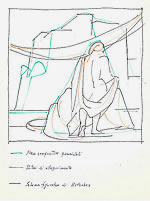 |
|
This morning I traced onto thin paper
some reproductions of my women with the intention of analysing their
composite structure and rhythms. I must also thank you for this because
your phrase “[…] the scene takes place in the late afternoon
with a blurred atmosphere and theatrical gestures […]” regarding
Rebecca, made me think of that musical rhythm “largo maestoso” which
was going over in my mind as I composed the painting.
To move from that point to thinking about the geometric plan of the
content and order which I always include in my preliminary studies
for the decoration of churches and indeed for all my paintings including
the biblical cycle was not hard. I started to check, to analyse what
I had done and no longer remembered. Some concepts came to mind which
I had mentioned during a series of conversations about drawing (and signs) many years ago, (part now of my indestructible cultural baggage
) about suggestions, the psychological impact of symbols on the observer:
the peace, and the infinite sense of the horizontal; ascesis, the tension
in the vertical; torment, the nightmare of broken lines, […]
and so on. And I realised much to my amusement that almost without
my knowledge these ideas are present in my paintings of the women […]” |
|
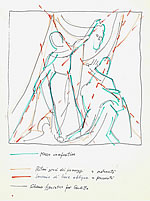 |
|
Two from the schemes drawn by the painter and
mentioned in the letter to Giorgio Segato.
On th left Bathsheba, on the right Judith. |
| |
|
|
|
|
|
|
|
|
|
|
| |
|
* Typewritten draft by E. Costantini,
April 1987 |
|
|
|
|
|
|
| |
|
|
|
|
|
|
|
|
|
|
| |
|
|
|
|
|
|
|
|
|
|
| |
|
|
|
|
|
|
|
|
|
|
| |
|
|
|
|
|
|
|
|
|
|
| From Why I painted “the women” * |
|
|
|
|
|
|
| |
|
|
|
|
|
|
|
|
|
|
| |
|
|
|
|
|
|
|
|
|
|
| |
|
[…] if on one hand the theme reflects
connotations of a distinctly Catholic extraction, the resulting work
reveals certain aspects which may well cause some puzzlement […]
in so far as, at first sight, viewed as a whole it may give the impression
of a distinct laicism, or at least, of a subtle avoidance of religious
significances present in the Book. This is not true. Because it is
to those exact meanings that I intended to refer by painting these
twelve pictures. Except that, as a result of my prolonged contact with
this theme, I have been led to consider those women, real women in
flesh and blood at last, as they were in reality, alive, rebounding
out of the biblical narration […].
[…] I wanted therefore, as far as possible, to remove from them
that burnt out halo of fake holiness in order to plunge them into their
existential condition, their destiny, which was a spiritual destiny
but also consisted of flesh and blood. Therefore to make them become,
as far as was permitted me by the moral implications of the theme and
my abilities as a painter, real living people, and not static figures
frozen in a not always enlightened traditional iconography […].
[…] In almost a year of work, face to face with the large white
surfaces of the canvases which were gradually filling up with shapes and
colours, I received confirmation, for myself first and I hope also
for those who will come across this work, the great gift that God granted
to and for Adam, and to all of us in this great story of the Man whom
He created “male and female“. |
|
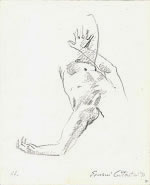 |
|
Study for Judith: Olofernes |
| |
|
|
|
|
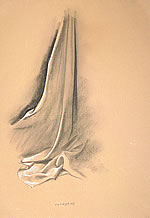 |
|
Study for Judith: drapery of Olofernes |
| |
|
|
|
|
 |
 |
 |
 |
 |
|
| |
|
|
|
|
|
|
|
|
|
|
| |
|
* Typewritten draft by
E. Costantini, (notes for a conference?) October 1985 |
|
|
|
|
|
|
| |
|
|
|
|
|
|
|
|
|
|
| |
|
|
|
|
|
|
|
|
|
|
 |
 |
 |
 |
 |
 |
 |
 |
 |
 |
 |
|

